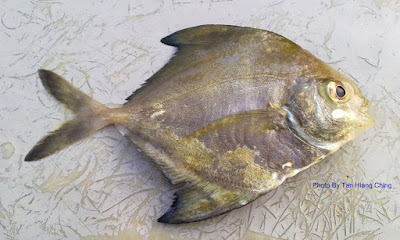Carangids (Black Pomfret)
The black pomfret belongs to the Carangidae family, a diverse group of fish species with highly variable body shapes. Common members of this family include jacks, scads, trevallies, queenfish, runners, amberjacks, pilotfish, and pompano. The carangids are distinguished from all other similar families in having the first 2 anal fin spines detached from rest of fin. These spines are sometimes partially or completely embedded in large adults of several genera, especially Seriola, Alectis, and Caranx and can only be found by dissection. Most species have spiny scutes along lateral line.
The carangids are marine fishes found in the Atlantic, Indian and Pacific oceans. Their habitats and behaviour are highly variable. Most of them are schooling species. Most species are fast swimming predators that hunt at or near the surface, mostly in oceanic waters, and often far offshore. Some root in sand for invertebrates and fishes.
There are altogether 30 genera and 147 species in the Carangidae family worldwide. The family has four subfamilies. Caranginae consist of a mixtures of 20 genera and 104 species like the threadfishes, trevallies, scads, horse mackerels, moonfishes, black pomfret, and etc. Naucratinae consist of 5 genera and 13 species also with many mixtures. Trachinotinae consist of 2 genera and 21 species of mostly pompanos. Scomberoidinae consist of 3 genera and 10 species of queenfishes (leatherjackets).
The black pomfret is the only species within the genus Parastromateus in the subfamily Caranginae. Found in tropical and subtropical waters, they are known for their distinctive flat body and nutritional value, making them popular in various cuisines.
The carangids are marine fishes found in the Atlantic, Indian and Pacific oceans. Their habitats and behaviour are highly variable. Most of them are schooling species. Most species are fast swimming predators that hunt at or near the surface, mostly in oceanic waters, and often far offshore. Some root in sand for invertebrates and fishes.
There are altogether 30 genera and 147 species in the Carangidae family worldwide. The family has four subfamilies. Caranginae consist of a mixtures of 20 genera and 104 species like the threadfishes, trevallies, scads, horse mackerels, moonfishes, black pomfret, and etc. Naucratinae consist of 5 genera and 13 species also with many mixtures. Trachinotinae consist of 2 genera and 21 species of mostly pompanos. Scomberoidinae consist of 3 genera and 10 species of queenfishes (leatherjackets).
The black pomfret is the only species within the genus Parastromateus in the subfamily Caranginae. Found in tropical and subtropical waters, they are known for their distinctive flat body and nutritional value, making them popular in various cuisines.
Scientific Name: Parastromateus niger (Bloch, 1795)
Common Name: Black Pomfret
Chinese Name | 鱼类中文名: 黑鲳 (Hēi chāng)
Malay Name | Nama Melayu Malaysia: Ikan Bawal Hitam
Thai Name | ชื่อสามัญภาษาไทย: ปลาจะละเม็ดดำ (Plā calamĕd dả)
Local Hokkien: Orr Cheoh
Local Cantonese: Hak Chong
Main Identification Features: Body deep, rhomboidal, strongly compressed. Body dark brown or black uniformly.
Size: Maximum total length 75 cm, commonly to 30 cm.
Habitat and Ecology: Soft bottoms, usually 15 to 40 m depth. Often occurs in large schools. Generally found near the bottom during the day, rising to near the surface at night. Swims on its side near the surface. Feeds on Bacillariophyceae, fish eggs and larvae, crustaceans, and all sorts of zooplankton.

Common Name: Black Pomfret
Chinese Name | 鱼类中文名: 黑鲳 (Hēi chāng)
Malay Name | Nama Melayu Malaysia: Ikan Bawal Hitam
Thai Name | ชื่อสามัญภาษาไทย: ปลาจะละเม็ดดำ (Plā calamĕd dả)
Local Hokkien: Orr Cheoh
Local Cantonese: Hak Chong
Main Identification Features: Body deep, rhomboidal, strongly compressed. Body dark brown or black uniformly.
Size: Maximum total length 75 cm, commonly to 30 cm.
Habitat and Ecology: Soft bottoms, usually 15 to 40 m depth. Often occurs in large schools. Generally found near the bottom during the day, rising to near the surface at night. Swims on its side near the surface. Feeds on Bacillariophyceae, fish eggs and larvae, crustaceans, and all sorts of zooplankton.
